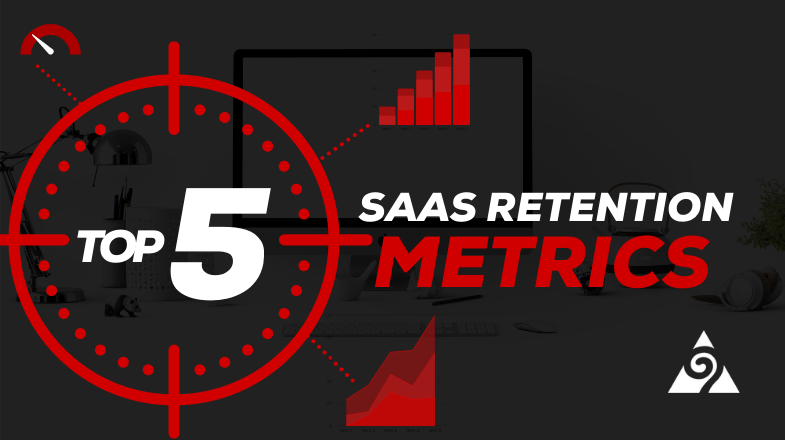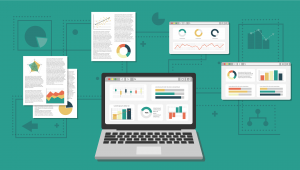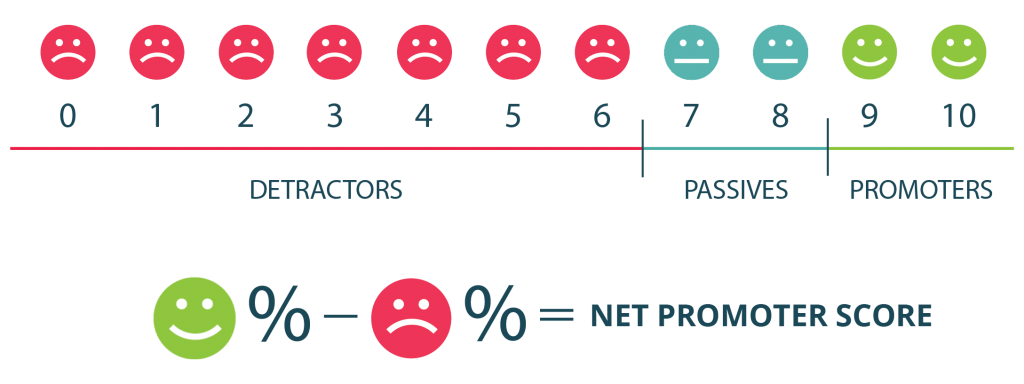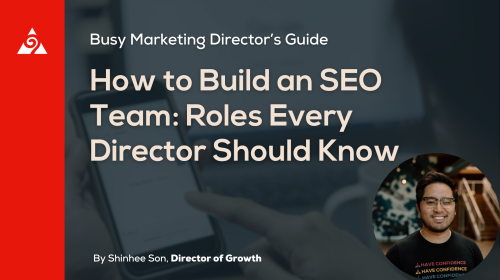SaaS retention metrics can be powerful tools for any software-as-a-service company. However, with numerous metrics to choose from, knowing which ones to use is just as important as choosing data-driven marketing in the first place.
SaaS is an extremely fast-growing market with new options for customers popping up every day. Focusing on user retention metrics can help your company emerge from the masses with a sustainable business model. To help, we created a list of the 5 best SaaS retention metrics to maximize your return of investment (ROI), growth, and sustainability.
- What Are SaaS Retention Metrics?
- Why Is SaaS Retention Key?
- Customer Retention Rate
- Monthly Recurring Revenue (MRR)
- Churn Rates
- Customer Lifetime Value (LTV)
- Net Promoter Score (NPS)
- Retaining SaaS Users
What Are SaaS Retention Metrics?
SaaS retention metrics are any measurements that you use to evaluate your customer retention. When we talk about customer retention, we mean everything we do to keep our existing customers.
Successful SaaS companies employ a variety of retention metrics and analyze them in conjunction with each other.
Understanding user retention metrics gives you a clear picture of your relationships with your customers. This allows you to adjust your business objectives and marketing strategies as needed to maximize customer retention.
HubSpot provides a free metrics calculator that helps you analyze many SaaS retention methods including:
- Customer retention rate
- Customer Lifetime Value (LTV)
- Net Promoter Score (NPS)
- Churn rates
Knowing which metrics to use and how to measure them is just the beginning. You need a user-friendly system of data management that allows you to consistently track these metrics. You will also need to understand how to analyze them effectively and use that information to drive your marketing strategies. Most retention metrics are calculated and analyzed monthly. This is particularly true for SaaS since SaaS companies most often use a subscription model in which customers sign up for a monthly recurring payment.
Why is SAAs retention Key?
Before we look more deeply at SaaS retention metrics, let’s get on the same page about why it matters.
According to Forbes, it costs 5 times more to gain a new customer than it does to retain an existing one. Customer retention is particularly important for SaaS providers as they tend to use recurring payments as their primary source of revenue.
Traditionally, marketers have focused more on customer acquisition than retention. However, there has been a definite shift in recent years to a stronger focus on user retention. And as your SaaS company ages, retention will become even more important.
At any stage of your SaaS company’s development, it is profitable to focus on user retention. If your marketing team is mainly focused on customer acquisition, it may be costing you money.
To get an idea of how much money you can save, look at your customer acquisition cost (CAC). How much does it cost on average to acquire a customer and how much lifetime value will they bring? Customer acquisition costs are often too high to be sustainable. That’s where retention comes in.
Still not sold on how important it is to retain SaaS customers? Here are some 2021 SaaS statistics to further prove our point:
- The median cost of acquiring a new customer is $1.18 for every $1 of revenue they bring.
- The average cost of generating $1 of additional revenue from an existing customer is $0.13.
- 52% of SaaS providers have increased the amount of money they are spending on retention.
- 56% of SaaS providers have labeled retention as a top priority.
The 5 best SaaS retention metrics
We all know that data is important, but out of all the available information on customer retention, you may not know which metrics you should be looking at. So, let’s delve deeper into the top 5 SaaS retention metrics, how to calculate them, and why they are important.
Customer retention rate
We measure customer retention using the customer retention rate. Of all the SaaS metrics, it’s one of the easiest to calculate.
Customer retention rate = (The number of customers at the end of a given period – new customers gained during that period) / The total number of customers at the start of that same period
To turn this metric into a percentage, simply multiply by 100. For example, say a SaaS company had 2,000 active customers at the beginning of September. At the end of the month, they had 1,600 active customers. They acquired 300 new customers in September. Therefore, they retained a total of 1,300 continuing customers (1,600-300). 1,300 divided by 2,000 gives us a customer retention rate of 0.65 or 65%.
The ideal customer retention rate varies depending on the company and target market. Generally, a rate of 35% or more means you are on the right track!
The customer retention rate is usually calculated over a period of one month. However, the period is adjustable. At Augurian, we like to evaluate how the customer retention rate changes over a period of several months and analyze that change in relation to what marketing strategies we were using at that time. This gives us an idea of what’s working effectively and what needs to be reworked.
If you want to increase your customer retention rate, reach out to one of our Augurs today. We will use a curated mix of SaaS retention metrics to create a personalized marketing plan for your company.
Monthly Recurring Revenue

MRR equals the average monthly bill times the total number of active customers that month. Your MRR will fluctuate each month, so it’s vital to track it regularly and compare monthly rates. Getting a solid grasp of your MRR will help you effectively analyze several other SaaS retention metrics.
To calculate your MRR, follow the steps below:
- Determine the total monthly revenue from subscriptions. Do not include any one-time fees or payments in this number as they will not occur monthly.
- Determine the total number of active subscribers you have at that time. Do not include trial subscribers since they aren’t bringing in revenue yet.
- Calculate the average monthly revenue per customer (ARPA) by dividing the total revenue from subscriptions by the number of subscribers.
- Multiple the ARPA by the total number of active subscribers.
For example, if a SaaS provider has 300 subscribers and their ARPA is $15, then their monthly recurring revenue from subscriptions is $4500.
Calculating MRR can get more complicated if you have different levels of subscriptions and different payment frequency options. If your clients pay quarterly, then to determine your MRR, you will need to divide your ARPA by 4.
If your SaaS provider has opportunities for additional revenue including upsells and add-ons, you can calculate this MRR separately. It is known as expansion MRR. For more information about the different types of MRR, check out our complete MRR guide.
MRR is great for evaluating your short-term goals and marketing strategies. For a wider lens, you should also calculate your annual recurring revenue (ARR). ARR is a key performance indicator for well-established companies and companies that rely solely on yearly subscriptions.
Churn
Churn is the rate of loss of customers or revenue over a specific period of time. This includes clients who don’t renew an expiring contract and ones who miss payments during the specified period.
Think of churn as the opposite of your customer retention rate. Therefore, you want a low churn. That means you have a low percentage of your total customers canceling their subscriptions.
Churn is considered one of the most important SaaS retention metrics. Now that you know how much it costs to gain a new customer, you understand how costly losing them can be to your ROI. Analyzing churn can help you understand why you are losing customers. Then, you can make a plan to keep them. This often includes strategies for increasing customer satisfaction, providing more customization, and building loyalty.
Rates of churn can be broken down into 3 subcategories:
- Monthly churn
- Annual churn
- Net churn rate
Monthly Churn
The monthly churn rate measures the number of customers who canceled their subscriptions or stopped using the SaaS service during a specified month. This metric is particularly valuable for SaaS providers who use the monthly subscription model.
Monthly churn rate = (the number of customers who cancelled in that month / the total number of customers at the start of the month) X 100
When calculating monthly churn, you can compare each month to the customer retention rate to see a more full picture of what your customers are doing. Our sample company had 2,000 total customers at the beginning of September. They had 700 customers cancel their subscriptions that month. So, their user churn rate for September was 35% compared to their customer retention rate of 65%.
Annual Churn
Some SaaS providers offer annual memberships only or as a cheaper option than monthly ones. For these companies, the annual churn rate may be a more effective metric. To calculate it, simply change the time period from a month to a year in the churn rate formula above.
An ideal annual churn rate is anything below 7%. This translates to a monthly churn rate of 0.58% This may seem impossible, but with targeted marketing strategies, it’s achievable. Let us show you how.
Net churn rate
Monthly and annual churn are often referred to as user churn since they measure the number of users lost during a given time period. Conversely, net churn measures the amount of lost revenue over a given time, usually one month. For this reason, it’s often called revenue churn.
To calculate your net churn rate, you first need to calculate your MRR, expansion MRR, and MRR churn. Then, use our simplified formula:
Net churn rate = (MRR churn – Expansion MRR) / The total MRR at the beginning of that month x 100
Revenue loss comes from customers canceling and also from downgrades. If you have different subscription options with varying price points, your net churn rate may be a better indicator for you to analyze than user churn. For example, you may have low user churn rates but high revenue loss if most of the churning customers had high-priced subscriptions. Make sure to include net churn rates in your data set for a complete picture of your SaaS churn.
Lifetime Value (LTV)
This metric measures the total amount of money a customer spends at your business on average. A customer’s running total starts the first time they spend money on your service and continues until they stop indefinitely.
A customer may churn by lapsing on a payment or downgrading subscription plans. However, they continue to provide value to the company until they cancel their subscription completely and permanently.
To measure LTV, you are going to need the ARPA metric and monthly churn rate that you calculated above. Then, all that’s left is to plug and chug some numbers.
Customer lifetime value = ARPA / Monthly user churn rate
For example, a company with an ARPA of $15 and a user churn rate of 35% (0.35) has a customer LTV of only $43. Looks like this sample company has a lot of work to do towards retaining SaaS users.
A good rule of thumb is that LTV needs to be at least three times the customer acquisition cost for your SaaS service to be cost-effective. This exemplifies the value of focusing on retaining SaaS users. The higher your LTV is, the more potential there is for a high return of investment.
Net Promoter Score
The Net Promoter Score (NPS) measures customer satisfaction using a standard 10-point scale. Some SaaS companies spend tons of time and resources creating elaborate surveys, but the NPS only asks one question that’s proven to provide usable data:
On a scale of 0-10, how likely is it that you would recommend this service to a friend or colleague?
The response scale is broken up into 3 categories:
- 0-6 = Detractors: These are unhappy customers who may be at risk of churning.
- 7-8 = Passives: These customers have a fairly neutral opinion of your service.
- 9-10 = Promoters: These customers are very happy with your service and likely to talk positively about it.
A high NPS is generally a good sign for user retention. You can use the promoter responses to determine what you are doing right. Plus, anytime a happy customer spontaneously promotes your service, it’s basically free advertising!
Customers with low NPS may be thinking about canceling their subscriptions soon. Looking at their answers can provide insight into how to keep these customers happy and increase the possibility that they will stay. This will in turn increase their LTV and your ROI.
How To Retain SaaS Customers
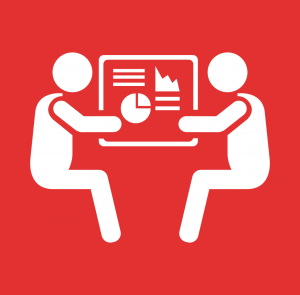
Are you inundated with data? Our Augurs can help you choose the right metrics for your marketing needs. We will help you keep churn down and avoid chasing costly new customers. By focusing on the customer experience, we can also improve your NPS. Allow us to help you unlock your full SaaS potential today.
